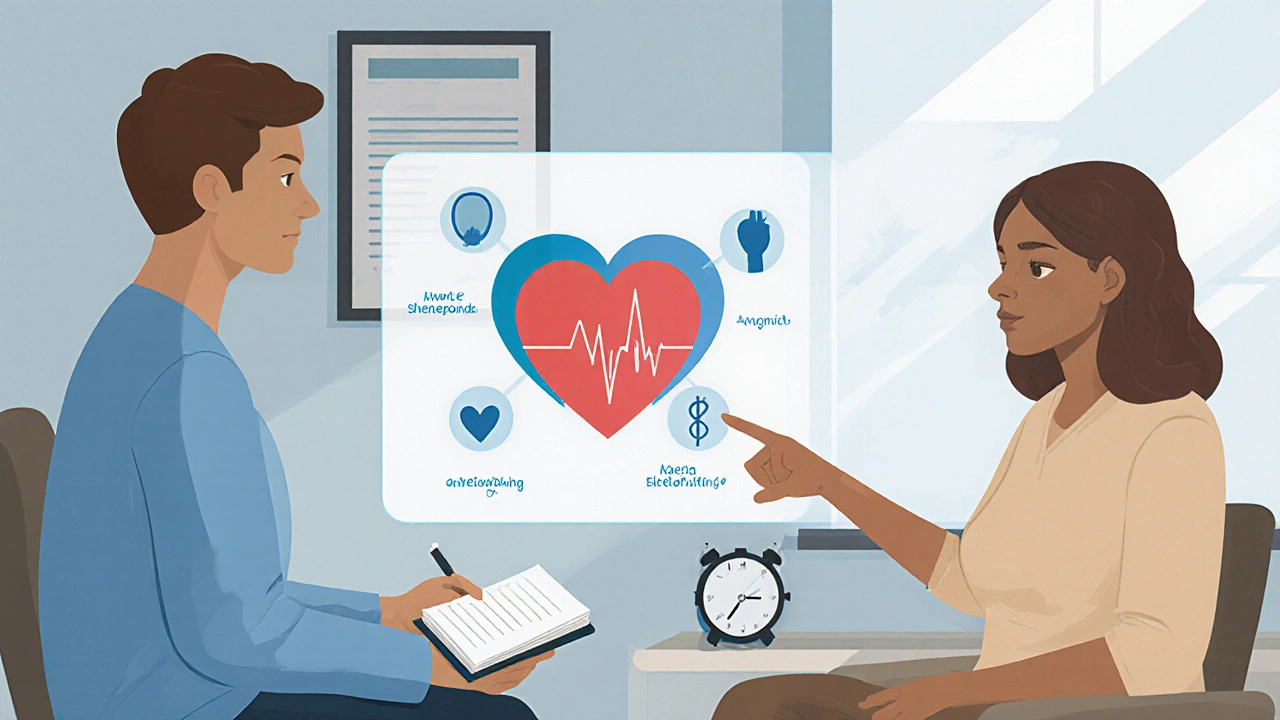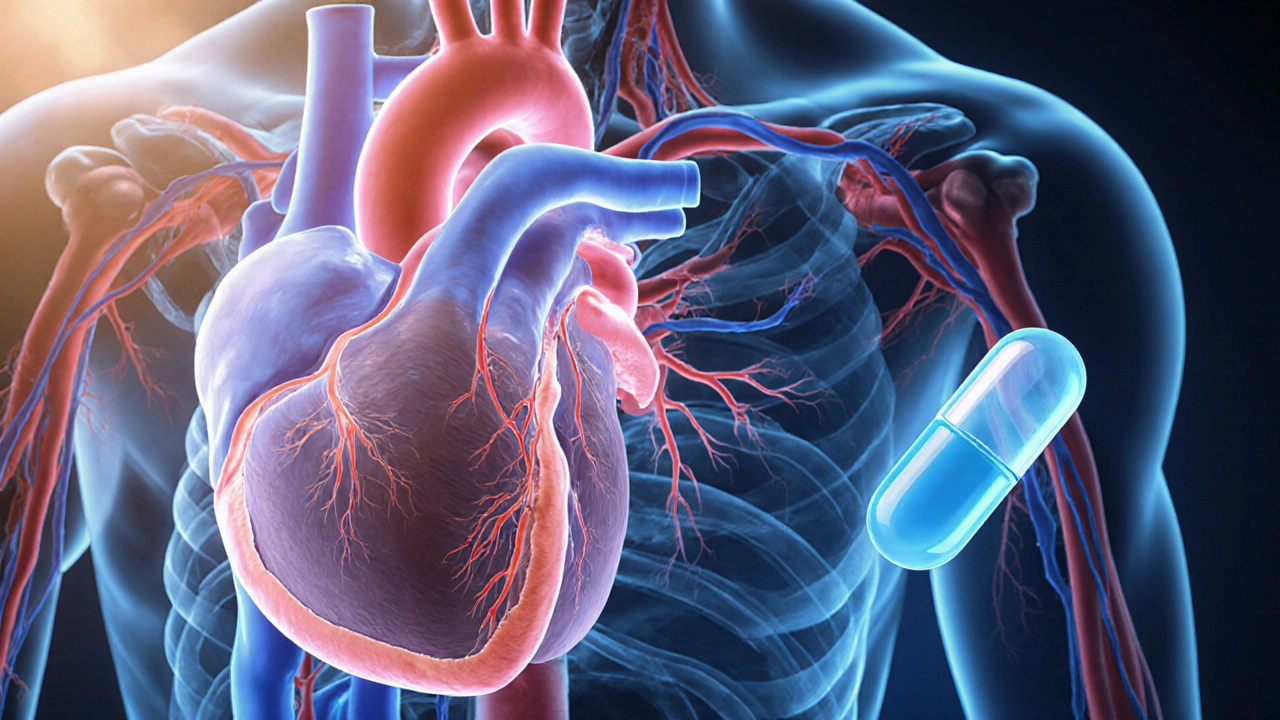Diltiazem Alternative Selector
Recommended Alternative:
Quick Takeaways
- Diltiazem works well for hypertension, angina, and rate‑control in atrial fibrillation, but it can cause swelling and low blood pressure.
- Common alternatives fall into three groups: other calcium‑channel blockers (amlodipine, verapamil, nifedipine), ACE‑inhibitors/ARBs (lisinopril, losartan), and beta‑blockers (metoprolol).
- Choose an alternative based on the primary condition, side‑effect tolerance, and dosing convenience.
- For patients who need stronger blood‑pressure control with fewer edema issues, amlodipine or an ACE‑inhibitor often tops the list.
- Always consult a prescriber before swapping drugs-some switches require a wash‑out period or dose adjustment.
What Is Diltiazem HCL?
Diltiazem is a non‑dihydropyridine calcium‑channel blocker (CCB) that relaxes blood‑vessel walls and slows heart‑rate conduction. It was first approved in the 1970s and is marketed worldwide under brand names like Cardizem and Tiazac.
Typical adult dosing ranges from 30mg up to 360mg per day, split into one or two doses. Its half‑life is about 3-5hours, but the extended‑release formulation stretches the effect to 24hours.
Key therapeutic uses include:
- Essential hypertension
- Stable angina pectoris
- Rate control for atrial fibrillation or flutter
Common side effects are peripheral edema, headache, dizziness, and occasional bradycardia.
How Do We Compare Alternatives?
When looking for Diltiazem alternatives, the goal is to match the drug’s strengths while mitigating its drawbacks. The three comparison axes are:
- Pharmacologic class: Does the alternative belong to the same class (other CCBs) or a different one (ACE‑I, ARB, beta‑blocker)?
- Clinical profile: How well does it treat hypertension, angina, or rhythm control?
- Tolerability & convenience: Dosing frequency, side‑effect burden, drug‑interaction risk.
Below is a side‑by‑side look at the most frequently considered substitutes.
Comparison Table
| Drug | Class | Typical Daily Dose | Half‑Life | Main Indications | Common Side Effects |
|---|---|---|---|---|---|
| Diltiazem | Non‑dihydropyridine CCB | 30‑360mg (split) | 3‑5h (ER≈24h) | Hypertension, angina, AF rate control | Edema, bradycardia, headache |
| Amlodipine | Dihydropyridine CCB | 5‑10mg once daily | 30‑50h | Hypertension, chronic stable angina | Peripheral edema, gum overgrowth, dizziness |
| Verapamil | Non‑dihydropyridine CCB | 80‑480mg per day (split) | 3‑7h | Hypertension, angina, SVT, AF rate control | Constipation, bradycardia, AV block |
| Nifedipine | Dihydropyridine CCB | 30‑90mg extended‑release once daily | 2‑5h (ER≈24h) | Hypertension, angina | Flushing, headache, reflex tachycardia |
| Losartan | AngiotensinII receptor blocker (ARB) | 25‑100mg once daily | 1‑2h (active metabolite 6‑9h) | Hypertension, diabetic nephropathy | Dizziness, hyperkalemia, cough (rare) |
| Lisinopril | ACE inhibitor | 10‑40mg once daily | 12h | Hypertension, heart failure, post‑MI | Cough, angioedema, hyperkalemia |
| Metoprolol | Beta‑blocker (β1‑selective) | 50‑200mg daily (split) | 3‑7h | Hypertension, angina, post‑MI, AF rate control | Fatigue, bradycardia, cold extremities |

When Diltiazem Works Well
If you’re already on diltiazem and it controls your blood pressure without major side effects, you’re probably in a good spot. Its dual action-vasodilation plus heart‑rate slowing-makes it a one‑stop solution for patients who need both hypertension and rhythm control.
Ideal scenarios include:
- Patients with hypertension plus chronic stable angina.
- Those with atrial fibrillation who also have high blood pressure.
- Individuals who cannot tolerate beta‑blockers because of asthma.
However, if you’ve noticed persistent ankle swelling, low heart rate, or uncomfortable headaches, an alternative might be worth a look.
Best Alternatives for Specific Needs
Amlodipine shines when edema is the main complaint. Its long half‑life means once‑daily dosing and less fluctuation in blood pressure. It lacks the heart‑rate slowing effect, so it’s better for pure hypertension or angina without rhythm concerns.
Verapamil is the closest pharmacologic cousin-another non‑dihydropyridine CCB. It’s useful when you need both vasodilation and strong AV‑node suppression, such as in supraventricular tachycardia. Watch for constipation and potential drug interactions (e.g., with cyclosporine).
Nifedipine (ER) is a dihydropyridine that focuses on vasodilation. It’s a solid pick for isolated hypertension or when you want to avoid heart‑rate effects altogether. Its main downside is reflex tachycardia, which can be bothersome for active patients.
Switching classes altogether can help if the problem is class‑related side effects. Lisinopril or Losartan offer blood‑pressure reduction without edema for many patients. ACE inhibitors like lisinopril are notorious for cough, while ARBs like losartan have a lower cough risk but may cause hyperkalemia.
For patients who need both blood‑pressure control and heart‑rate reduction but can’t tolerate CCBs, Metoprolol (beta‑blocker) provides reliable rate control and modest antihypertensive effect. Fatigue and cold hands are typical complaints, and beta‑blockers are contraindicated in severe COPD.
Decision Flowchart (Text Version)
Use this quick mental checklist before you ask your doctor about a switch:
- Is edema your biggest issue?
→ Consider Amlodipine or an ACE‑I/ARB. - Do you need strong AV‑node blocking?
→ Verapamil or a beta‑blocker like Metoprolol. - Are you avoiding cough?
→ Choose an ARB (Losartan) over an ACE‑I. - Do you prefer once‑daily dosing?
→ Amlodipine, Losartan, Lisinopril, or extended‑release Nifedipine. - Any drug interactions (e.g., with statins, anti‑arrhythmics)?
→ Review each alternative’s metabolism (CYP3A4 for many CCBs).
Potential Pitfalls When Switching
Changing from diltiazem to another agent isn’t just a pill swap. Common mistakes include:
- Skipping a wash‑out period: Some CCBs overlap in effect, risking excessive blood‑pressure drop.
- Under‑dosing the new drug: New agents often need a titration phase; starting too low delays therapeutic benefit.
- Ignoring renal function: ACE‑I/ARBs require dose tweaks in CKD; forgetting this can cause hyperkalemia.
- Overlooking drug interactions: Metoprolol metabolized by CYP2D6; inhibitors can raise levels unexpectedly.
Always schedule a follow‑up within two weeks of a change to gauge blood‑pressure response and side‑effect profile.
Frequently Asked Questions
Can I replace diltiazem with amlodipine if I get ankle swelling?
Yes. Amlodipine is less likely to cause edema because it’s a dihydropyridine CCB. Your doctor will usually start at 5mg daily and monitor blood pressure and any new side effects.
Is verapamil a better choice for atrial fibrillation?
Verapamil provides stronger AV‑node inhibition than diltiazem, so it can be more effective in controlling ventricular rate during AF. However, it can cause constipation and may interact with digoxin.
What about using an ACE inhibitor instead of a calcium‑channel blocker?
ACE inhibitors like lisinopril lower blood pressure by blocking the renin‑angiotensin system and do not cause peripheral edema. They’re a solid alternative for patients who can’t tolerate CCBs, but watch for a dry cough or, rarely, angioedema.
Do beta‑blockers replace the need for diltiazem in angina?
Beta‑blockers such as metoprolol reduce heart‑rate and myocardial oxygen demand, which helps angina. They don’t dilate coronary vessels as CCBs do, so some patients benefit from a combination rather than a complete swap.
How quickly will blood pressure change after switching meds?
Most alternatives reach steady‑state within 3‑5 days (once‑daily agents) to 2 weeks (extended‑release). Your doctor may check your reading after 5‑7 days to decide if further titration is needed.

Final Thoughts
Choosing the right alternative to diltiazem hinges on three questions: What condition are you treating? Which side effects bother you most? How much dosing convenience do you need?
For pure hypertension with minimal swelling, amlodipine or an ARB like losartan often win. If you still need rhythm control, verapamil or a beta‑blocker is the logical step. When you can tolerate a modest amount of edema but want better heart‑rate control, staying with diltiazem or moving to a dihydropyridine CCB plus a low‑dose beta‑blocker could be the sweet spot.
Talk to your prescriber, discuss these trade‑offs, and set a follow‑up plan. The right switch can improve blood‑pressure numbers, reduce uncomfortable side effects, and keep you feeling on top of your health.


David Lance Saxon Jr.
When we contemplate the pharmacodynamic topology of calcium‑channel antagonism, diltiazem occupies a liminal nexus between vascular smooth‑muscle relaxation and nodal conduction attenuation; this dualism engenders a therapeutic equipoise that is both a virtue and a liability, especially when peripheral edema surfaces as a clinical harbinger of fluid redistribution.